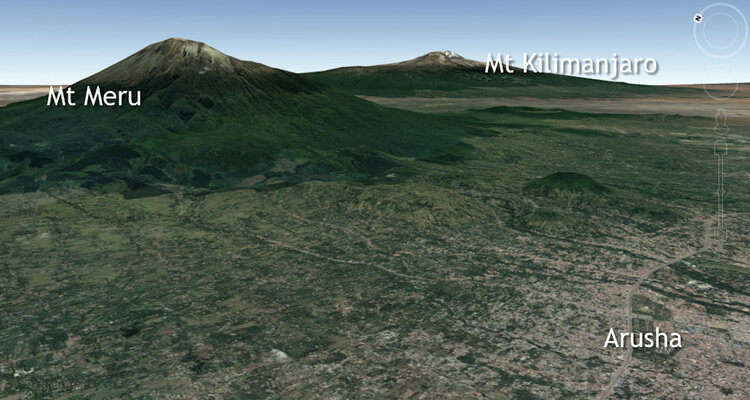“Something, or something awful or something wonderful was certain to happen on every day in this part of Africa. Every morning when you woke it was as exciting as though you were going to compete in a downhill ski race or drive a bobsled on a fast run. Something, you knew, would happen, and probably before eleven o’clock.”
Ernest Hemingway, True at First Light ( 1999:19)
A muddy morning in Arusha. Elevation makes Arusha cooler than other areas of Tanzania. While July and August are generally dry months, it can rain anytime, as we learned.
It was nine o’clock in the morning when Mr Nixon nosed Toyota-in khaki (TIK) onto the street of packed earth. And we were excited.
Part of the excitement grew from the landscape itself.
If you look down at a map, you’ll find Arusha in the East African country of Tanzania, roughly half-way between Cairo and Cape Town. It is about two-hundred miles south of the equator and two-hundred miles inland from the Indian Ocean.
Image courtesy of Google Earth.
The scale reveals more than a dozen national parks, forest reserves, and game reserves within a 100-mile radius from its center. And this is just on the Tanzanian side of the border. The natural richness of Kenya is also within reach. You can see all of this if you look down at a map.
If you look up from Arusha’s streets, you’ll likely find a cinder cone peering back. Maybe two. Mt Meru is the fifth tallest mountain in Africa, ringing in at just under 15,000 feet. Sixty miles to the northwest is Ol Doinyo Lengai, a bubbling blowhole that has erupted three times in the last century. Forty miles to the northeast, Mt Kilimanjaro rises more than 19,000 feet and is the grand old man of them all. Arusha is spread like a stained tablecloth in this volcano alley. Deep rumbles beneath suggest that the crafting of this landscape is a work-in-progress.
Mr Nixon navigated the potholes on the street. Some of these were the ordinary teeth-rattlin’ kind. TIK’s stiff suspension was built for this. We lurched in our seats but bounced on. Other potholes—not all of them marked—were capable of swallowing a truck whole.
The ubiquitous motorbikes of Africa buzzed around. Arusha was slowly waking. It lolled under fat clouds.
Image courtesy of Google Earth.
Another part of our excitement grew from the intersection of this majestic landscape with the raw challenges of life.
Papa knew this all too well.
Ernest Hemingway was fascinated with Africa as a boy, visited it twice, and on both occasions it nearly killed him. On his second safari of 1953-54 Papa’s plane crashed, twice. Only by bashing the jammed door open with his own head did he escape the flames.
He read his own obituary (with pleasure, it was reported!) while recovering in a hospital in Entebbe, Uganda.*
On his first safari, twenty years earlier in 1933, he spent his last night in luxury, right here in Arusha. And like us, he followed the road west through Kisongo and Mto wa Mbu to Lake Manyara and up the wall of the Great Rift. Unlike us, however, he contracted a case of amoebic dysentery along the way that was so severe that his large intestine prolapsed. He had to wash and push it back in while waiting to be airlifted to the hospital.** He undoubtedly drew from his own experiences of sickness and airflight when describing the character of Harry in “The Snows of Kilimanjaro.”
I was familiar with Papa’s story and knew going in that this was a hard land. One naturally associates East Africa with lions, leopards, and hyenas, carnivores of tooth and nail. But just as deadly are critters of jumbo size, such as the buffalo or elephant, and—even more so—critters so tiny that the human eye cannot see them without assistance. Those of the latter group include parasites that cause malaria, bacteria that communicate cholera, and viruses that cause HIV. These stalkers are the most dangerous.
TIK rumbled past Hemingway’s eleven o’clock without difficulty.
Zebu cattle accompanied by a stick-wielding herder.
We left the clutter of Arusha behind and the country opened up. It was broad and mellow and cast in earthen shades. A light breeze brushed the tall grass. Clusters of thorny acacias gathered along the hills. Between these were watering- and mud-holes), baked by the sun and trampled by cows. Small herds, accompanied by the lanky Maasai, formed irregular lines of march to and from the water. Tenders carried sticks and wore sandals cut from old tires. They were, however, indifferent to our wheels and did not turn their heads as we passed.
We rumbled along in silence. Suddenly Vicki shouted.
“A zebra!”
She pointed to an opening in the brush. It took me and Mr Nixon a moment to find it. Only a black and white flank was visible.
It was something wonderful indeed.
“We have us a spotter,” Mr Nixon chuckled.
The country opened up, broad and mellow with earthen shades.
*See Philip Young’s Ernest Hemingway: A Reconsideration (1966: 267).
**See Keith Ferrell, Ernest Hemingway: The Search for Courage (1984:158-159).
If you are a traveler, church leader, or educator who is interested in visiting Israel-Palestine (or Tanzania!), let me hear from you. I partner with faith-based groups to deliver outdoor academic experiences. Leaders receive the same perks that other agencies offer, at competitive prices and without the self-serving interests.
Right now we’re building the passenger roster for an Israel excursion scheduled for March 17-28, 2020. Seats will be open until Thanksgiving. For a list of trips go to the link here or contact me at markziese@gmail.com.







